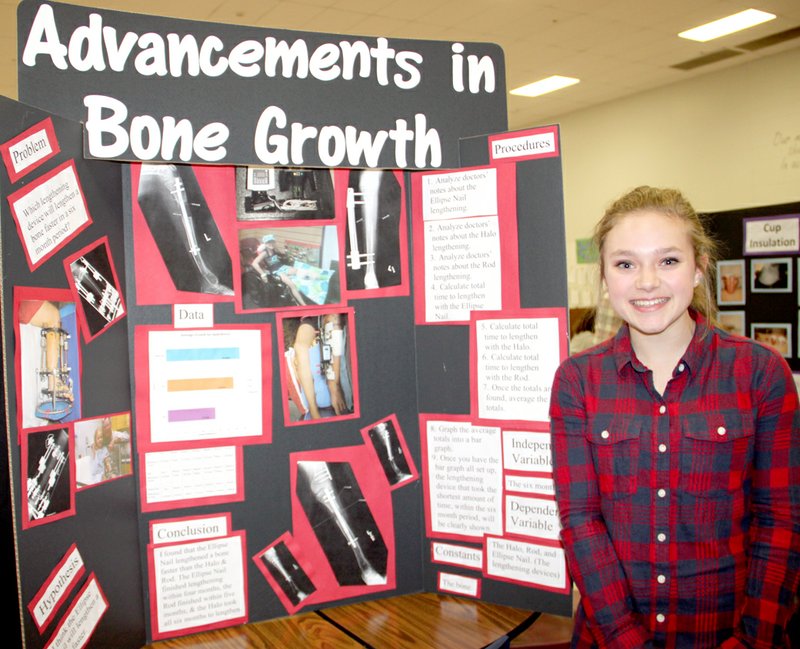FARMINGTON -- Lynch Middle School student Madison Osnes used her own personal experiences from the past 14 years in deciding what topic to pick for her eighth-grade science fair project.
Her question was, "Which lengthening procedure will lengthen a bone faster in a six-month period?"
Osnes' project was one of many available for viewing at the middle school's Math and Science Family Night held recently in the commons area. Children could play math games and parents and other visitors were able to spend time looking over science fair projects completed by Laurie Voss' eighth-grade students in pre-Advanced Placement physical science.
Daniel Barth, an astronomy professor from University of Arkansas, talked with students about the possibility of starting an astronomy club at the middle school.
Madison, 14, was born without a fibula bone in her left leg and without two toes on her left foot. The scientific name for the condition is libular aplasia. To remedy the condition, doctors broke her tibia in half and she has used three devices over the years to lengthen the tibia bone so that it would grow back together.
For her science fair project, Madison used X-rays and other information from her procedures to determine which one worked best in lengthening a bone. Each treatment lasted six months so that was the time frame used in her project.
The first device, called a Halo, was attached externally to her leg and bone through surgery when Madison was only 9 months old. Her parents had to turn notches on the instrument every day. At the end of six months, her bone had grown 27.5 mm.
Madison underwent her second surgery to lengthen the bone when she was 9 years old and this time, doctors attached an instrument called a Rod to her left leg and bone. Her parents did not have to turn notches on this device because it was computerized. At the end of six months, her bone had grown 38.4 mm.
Her third surgery to lengthen the bone produced the best results and her tibia bone has grown back together. She had a device called an Elipse Nail inserted into her leg. This device will be removed this summer but within four months, her bone had lengthen by 42.6 mm.
In all, Madison has undergone 11 surgeries for different issues related to her leg and the last and final surgery will be the one this summer to remove the Elipse Nail device.
Through the devices and surgeries, Madison said she now can do anything she wants to do.
Other science fair projects were more typical but also gave students opportunities to come up with a question, make a hypothesis and conduct experiments to see if their hypothesis was correct.
Karyssa Butler wanted to find out which wood-glue works the best. Her family has wooden chairs that break a lot and she wanted to determine which wood glue would be best in repairing the chairs. Her guess was that Gorilla Glue was the best but her tests showed that Titebond worked the best.
She glued two boards together, using a different wood glue for each set. Then she used weights to determine the breaking point for each set of boards. Titebond held 47.45 pounds before it broke in two.
"I liked it. It was fun to learn how it actually turned out since I was way wrong," Butler said.
Theresa Markwardt wanted to know which gave off more electricity -- fruits or vegetables. She guessed fruit and her experiment proved she was right. Using a voltmeter, copper wire and a zinc nail, Markwardt calculated the voltage generated by different kinds of fruits and vegetables. Fruit gave an average of .799 volts of electricity and vegetables gave an average of .662 volts of electricity.
The project showed her that fruits and vegetables can be used as a means of electricity but it would take a lot of each to make it worthwhile, she said.
Voss said science fair projects teach her students how to analyze data and write reports.
"I'm proud of the stuff they turned out," Voss said.
General News on 03/25/2015
